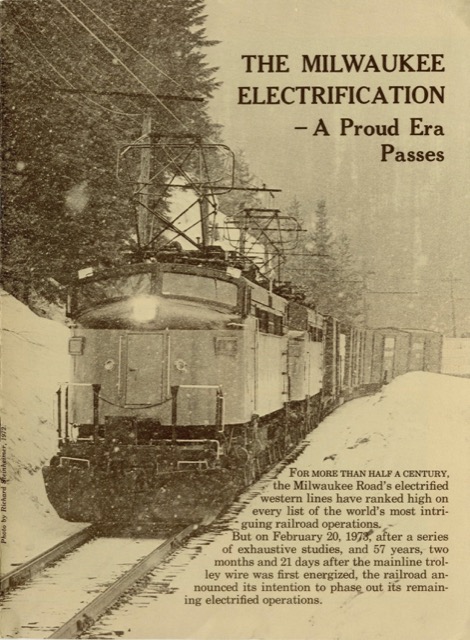Soon after the Milwaukee went way over budget finishing its Pacific Extension in 1908, it decided to spend even more money electrifying the portions of the route in the Rocky and Cascade mountains. Electrification was all the rage in the early 1900s; Pennsylvania, of course, electrified its lines from New York City to Harrisburg and Washington, DC, while Southern Pacific considered electrifying Donner’s Pass. When Milwaukee opened its electrified route in 1915, it was proud to say it had the longest electric line in the country.
 Click image to download a 11.2-MB PDF of this 12-page booklet.
Click image to download a 11.2-MB PDF of this 12-page booklet.
Electrification of portions of the route made a lot of sense in the steam era when trains changed locomotives every few hundred miles anyway. But Diesels could go all the way to Seattle without being changed, so having to change them four times to go over two mountain ranges was a hassle. By 1973, the railroad was still using some of the original, 1915 locomotives, and its electric infrastructure was worn out. Even though General Electric offered to finance replacement costs, the company decided to go to an all-Diesel system.
It probably regretted that decision, as oil prices suddenly skyrocketed at about that time, which made the nearly free hydroelectric power seem pretty attractive. No doubt many Milwaukee fans wonder if the Pacific extension would have survived, instead of being scrapped in 1980, if the railroad had retained the electric system.

I was lucky enough to get up to Avery In 1971 and see the MILW operation when it was still under wires. The whole thing was like an operating museum. The Little Joes were the youngest units and they were already over 20 years old. However, it was really the board of directors in 1946 that assured the end of electrification. GE offered MILW all 20 of the Little Joes plus an extensive inventory of spare parts for the amazing sum of $1 million. Ignoring the spare parts, that’s $50,000 a locomotive at a time when a four unit set of F units, which had about the same horsepower as a Joe, cost about $650,000! MILW was cash strapped at the end of WWII and had spend huge amounts of money to rehab the railroad. It wasn’t in good shape before the war, and war traffic had pounded the road to pieces. Even the obvious bargain couldn’t pry the money loose from the board at the time.
By the time the Korean War started, most the rehab work had been completed and the MILW was short of motive power. They went back to GE to purchase the Joes and GE was happy to sell them for $1 million again. This time, however, that was for just 12 locomotives and no spare parts, since a Brazilian railroad with more money and the South Shore had purchased eight between them as well as all the spare parts. The MILW was over a barrel and coughed up the money. It has been endlessly debated about what would have happened if the MILW had purchased all 20 and the spares in 1946. 20 of Joes would have handled most of the Rocky Mountain District traffic for the foreseeable future. Spare part would not have turned into the nightmare it later did, with the road having to custom make many parts unavailable from GE. Would 20 operating Joes have saved the Pacific Division? Probably not, as the MILW was already in big financial trouble, and track and physical plant on the Pacific Extension was completely worn out from deferred maintenance. More Joes with those spare parts may have extended electric operation until abandonment of the line in 1980 but they wouldn’t have saved the division. The MILW is a history of one bad decision after another, and its ultimate end was inevitable for many decades before the axe finally fell in 1984.